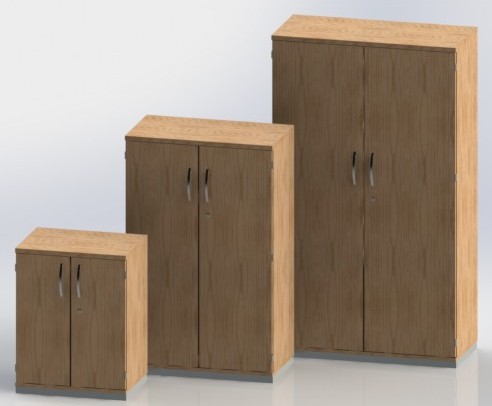Parametric models
SOLIDWORKS® is offering state of the art solutions to design three-dimensional solid models with its latest parametric modeling technology. PASCAM has developed the capability to enrich those parametric models with semantic information, which is at the moment the most powerful method to use and operate this type of solid models very flexibly and highly dynamic. The additional semantic information can be applied for example to implement fast and easily certain design rules or references between individual objects of an assembly (e.g. door leaf is positioned in a specific way to a cabinet case).

Parametric modeling is the creation of solid models by
means of parameters. As a general rule each parameter that is used
to create geometrical elements can be a subject of changes and
modifications - these changes will result in modifications of the
part and of the associatively derived geometry of the solid body.
You can establish links between the original elements (parameters)
and the resulting elements (associativities). The links are build up
hierarchically, the primary element is quasi the "parent" of all
other elements, which are built on top of it.
The comprehensive parametric modeling is practically applied at the PASCAM Variable management.
The benefit of parametric modeling with semantic information is the optimal reusability of proven design components, the best possible record keeping and documentation of engineering procedures and intentions of the designer for each component and assembly - which is a crucial point in a work-sharing design and manufacturing process in which the members of the same design team are able to share their work in the joint design process easily among each other, because the individual design efforts are transparent and easy to understand.
Another advantage for customizing product models and variant design is the capability to modify models very rapidly in all aspects, including the CNC programming for manufacturing. Because the sequence of design steps, as well as the geometric parameters are saved chronologically in a clear and transparent order.
The fundamental advantage of this history-based modeling is its transparency and the high degree of flexibility. Thus the "final" model geometry can be adjusted any time afterwards in various ways by editing and modifying the underlying individual design steps. Additionally the fully parametric 3D product model will contribute to the decline of 2D drawing printouts into insignificance, due to the fact that the extensive information content of the SOLIDWORKS® model isn't visible on such primitive media, eDrawing files will be used instead to share design information in a safe and convincing way, e.g. by enabling viewers to add comments to the 3D product model and discuss online about change requests.